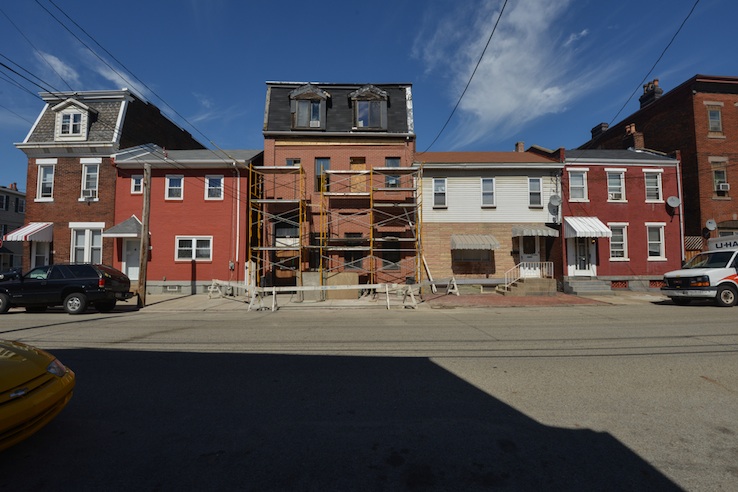City housing market strong as region’s recovery continues
Southwestern Pennsylvania’s housing market, which missed the mid-decade boom experienced elsewhere across the nation, remains in the midst of a solid recovery, particularly in the City of Pittsburgh, where shifting demographics are turning many neighborhoods decidedly younger.
Evidence of steady improvement was again seen across a number of measures in 2012. Perhaps most important, the appreciation of home values in the seven-county Pittsburgh Metropolitan Statistical Area remained the envy of most of the 14 Pittsburgh Today benchmark regions.
Third quarter home prices appreciated 5.8 percent in the Pittsburgh MSA from 2007 to 2012, ranking southwestern Pennsylvania at the top of all of the benchmark regions. In fact, it was the only region in which five-year housing prices rose. In Denver, which had the second-best five-year appreciation rate, prices fell 1.8 percent. In Baltimore, Minneapolis and Detroit housing prices dropped 20 percent or more.
Looking back 10 years, housing prices in the Pittsburgh MSA are up 26 percent, well above the 16.6 percent national appreciation rate.
One trademark of the region’s housing market is that it has long been short on drama, which has served it well in recent years. The region didn’t experience much of a housing bubble in the first decade of this century and was spared the ruinous consequences of sharply contracting markets that other places endured after the bubble burst.
“It was slow and steady here,” said Sabina Deitrick, director of the Urban and Regional Analysis Program at the University of Pittsburgh University Center for Social and Urban Research (UCSUR). “Some people may have been upset that our prices weren’t going up like other places. But we don’t have many people who are underwater.”
Low mortgage rates have helped home sales in the region and elsewhere. Region-specific factors have also helped keep southwestern Pennsylvania’s post-recession housing market healthier than most, not the least of which has been a steady economy, including higher job growth and a low cost of living. And more people have moved into the region than have left in recent years, and they tend to be better-educated young adults migrating to job opportunities.
Rising demand in the city
Several City of Pittsburgh neighborhoods are emerging as desirable places for live, particularly among young adults, and the trend is having an impact on housing.
“Housing values in a lot of neighborhoods of Pittsburgh are strong,” Deitrick said. “There isn’t a lot of product in the city housing market, and when supply is less than demand, prices are stable or rising. That’s the case in a lot of neighborhoods.”
Demand is being driven by homebuyers and renters alike. The rental market, in fact, has recently gained strength – a trend that at long last includes Downtown Pittsburgh, which is experiencing a surge in apartment development.
An UCSUR survey of people who recently moved to Lawrenceville offers a glimpse of what is attracting new residents to up-and-coming city neighborhoods. Nearly 53 percent listed the cost of living as a major draw, and 44 percent said living closer to work or school was a key attraction. About two-thirds of survey respondents were young adults between the ages of 18 and 34.
Lawrenceville is one city neighborhood that has undergone profound changes in recent years. After years of steep decline, its population has stabilized and gotten much younger. In 1990, more than 25 percent of its residents were 65 or older. Twenty years later, they accounted for only 16 percent.
The demographic shift coincided with community development efforts ranging from business district improvements to reducing crime and blight. The neighborhood emerged as a choice residential and shopping destination. And housing values, driven by demand, have soared.
The average price for residential property in Lawrenceville has risen 104 percent since 1995. In the Lower Lawrenceville section, where demand is the highest, residential property values have risen 160 percent. The average housing price across the City of Pittsburgh increased 24 percent over the same period, by comparison.
The demographic shift is not confined to a few neighborhoods. The young adult population rose 17 percent in the city from 2000 to 2010 with 50 neighborhoods experiencing an increase. And nearly half of neighborhoods lost more than a quarter of their residents aged 65 or older – a trend that is expected to reverse in the coming years as more Baby Boomers reach retirement age.
This aging trend will be felt across the nation and affect both cities and suburbs. The impact on housing could be significant as greater numbers of empty nesters reconsider that four-bedroom home in the suburbs with a lawn to tend. While snowbirds will migrate to warmer climates, other aging Boomers offer cities like Pittsburgh an opportunity to weather the change gracefully. “For the set of folks who are not ready to hit the retirement home and want to be in an urban place, but don’t want a high cost of living, places like Pittsburgh are attractive,” said Deitrick.





